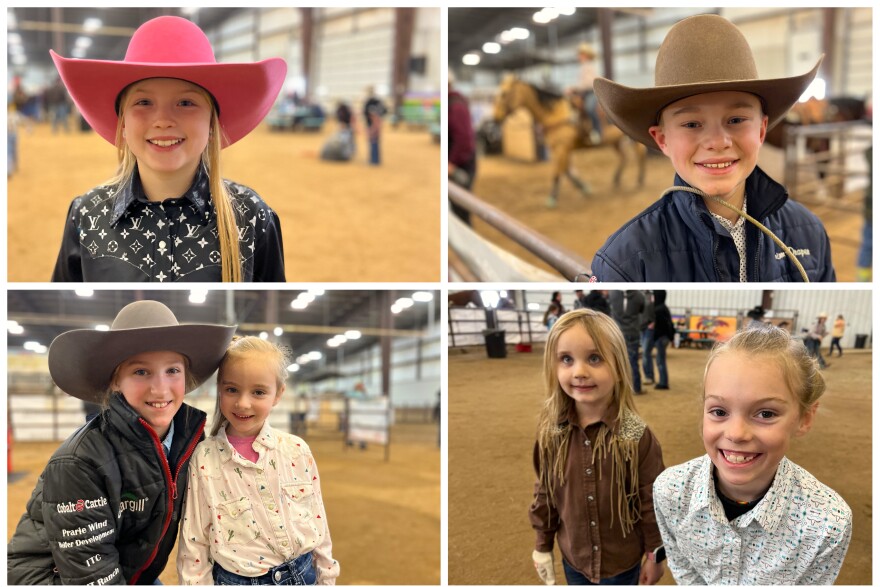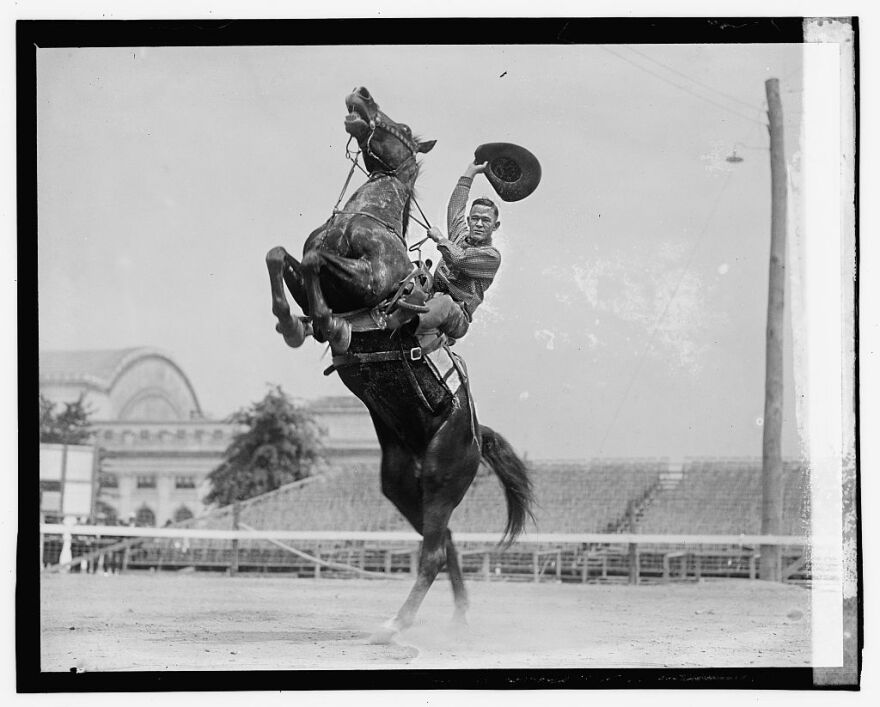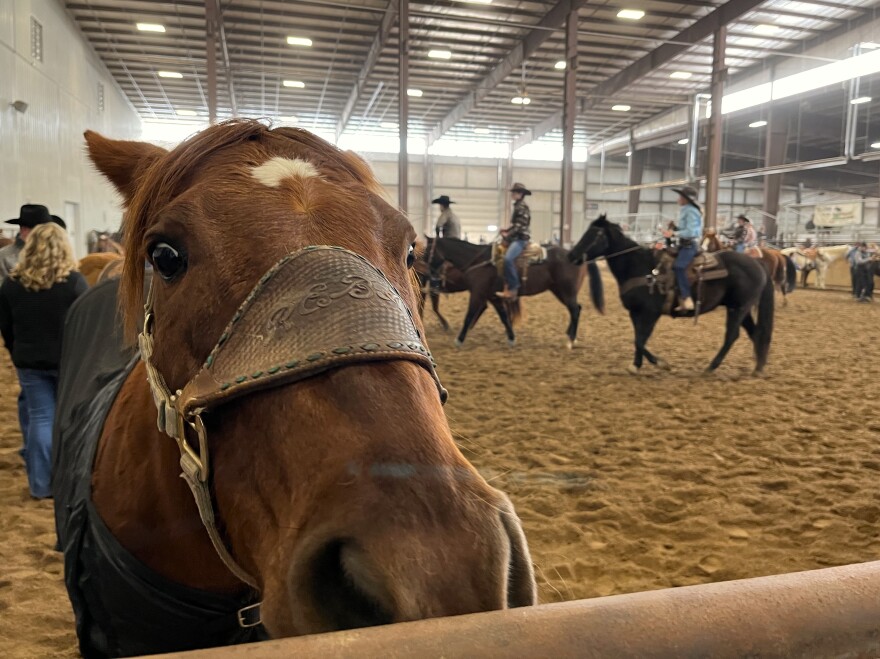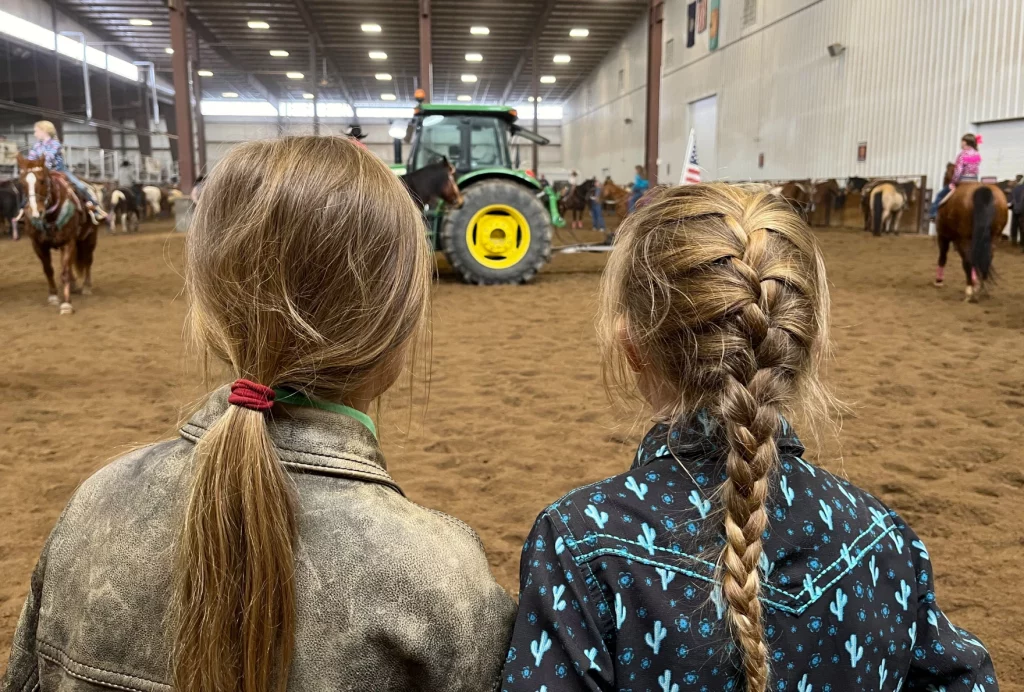Dodge City, KS— How do you turn kindergartners into wranglers?
“Little bitty saddles,” Melissa Vander Hamm said, “for little bitty kids.”
There’s a bit more to youth rodeo than that. You need your own horse. Plus a trailer to haul the horse and a truck to tow it all. To ride, you’ll need one of those little saddles and a bunch of other tack, which could put you back thousands of dollars.
In all, a youth rodeo family is an extensive, expensive commitment to living the rural Western lifestyle.
But Vander Hamm knows all that. She’s been competing in rodeo since she was nine years old. Her two sons started at age five. Now, she helps run the Young Guns Extravaganza, a youth rodeo series in Dodge City.
“It’s not a cheap hobby,” Vander Hamm said. “Drive through our parking lot on rodeo weekend and the amount of money just in pickups and trailers … it’s crazy.”

For rodeo families — most of whom, she said, come from agricultural backgrounds — the cost of competing is worth every penny as they look for ways to sustain their traditional way of life and their town’s population of young folks.
In a place where farms and ranches go back generations, rodeo is sewn deep into the cultural fabric of rural Kansas. But the number of people living in the region’s small towns has been shrinking for decades as young adults leave the rural life for bigger cities. Most counties in western Kansas have been steadily emptying since the Dust Bowl.
And parents like Vander Hamm, who lives in the neighboring town of Ingalls (population 288), hope that introducing more kids to the rodeo world might spur them to fall in love with their hometowns’ cowboy culture. Then maybe when those kids grow up, they’ll want to get back in the saddle again.
“The ones that do love it,” Vander Hamm said, “are inclined to come back and be part of the family farm.”

Despite any financial barriers to getting started, youth rodeo is growing.
Vander Hamm founded Young Guns in 2014 with a few other parents who wanted their kids to get more practice during the winter, when other competitions shut down.
The first year, she expected around 50 kids to show up. She got 120.
This season, Young Guns has welcomed nearly 400 little cowpokes into the arena, as they dummy rope, pole bend or barrel race their way to glory. And it’s just one of several youth rodeo associations across the state.
“I do think it’s a trend,” Vander Hamm said. “It’s a time when it’s cool to be a cowboy.”

Back in the saddle
On rodeo day, hundreds of horses trot through an expo center on the south edge of Dodge City. They kick up fine brown dust from the arena floor into clouds that hang in the air.
The morning starts with a prayer from the rodeo chaplain. Then comes the national anthem as the Miss Santa Fe Trail Queen gallops in with a flag.
Mesa Hedland stands near the arena entrance decked out in a brown Western shirt with leather tassels dangling from leopard print shoulder patches.
She’s waiting for her favorite event, which involves chasing down a goat and untying a ribbon from its tail, with help from her trusty steed named Ott.

“He’s addicted to me,” Hedland, who’s from Anthony, Kansas, said. “We can’t spend a day without hanging out with each other.”
Hedland is only five years old, but this is far from her first rodeo. She’s been chasing those goats since she was three.
In the horse warm-up area, nine-year-old friends Paisley Davis and Braylin Barratt offer a tour of the bridles and stirrups strapped to their four-hoofed friends. The pair live a few hours apart in southern Colorado, so they’re making up for lost time here.

Listening to them as they inspect their saddles and laugh about the odd things one particularly ravenous horse has eaten, it’s not hard to spot what rodeo families see as the upside of all this and what they hope kids take away from the experience.
The hard work it takes to care for an animal 10 times their size. The hours of practice required to master skills that most adults can’t pull off. The grit they need to ride into the arena — where every kid but one ends up leaving a loser.
“Be grateful that even though you didn’t win, someone else won,” Barratt said. “Always be grateful.”
And the bonds they form — with people and animals — along the way.
Davis walks up to her horse Thunder until the two stand eye-to-eye. She rests her hand on his neck near the black mane that she’s carefully woven into braids.
“When you do have a bad day,” Davis said, “you can just talk to your horse about it.”

The rural mystique
Gene Theodori, a sociology professor at Sam Houston State University in Texas, isn’t surprised to see events like Young Guns growing. Rodeo’s enduring appeal, he said, comes back to the idea that rural America is the last remnant of a bygone, simpler lifestyle.
He calls it the rural mystique. And rodeo is a picture of that in its purest form.
“Whether it’s real or not,” Theodori said, “in our minds, it represents that wholesome rural way of life. … And we, as a society, we yearn for that.”

What we’re seeing now, he said, is just the latest of many waves of interest in old-time Western culture that have washed over American society, especially as the country’s become more suburban and urban.
In the 1950s and 1960s, there was a surge of interest captured by the popularity of cowboy songs from Marty Robbins and Roy Rogers and big-screen Westerns starring John Wayne and Clint Eastwood.
Now, the Old West has come back again in a big way. Theodori describes the current wave as the “Yellowstone” effect, in reference to the TV show about a powerful Montana ranching family that’s become the most-watched drama on television.
And he predicts that the “Yellowstone” effect could drive a spike in people from all walks of life wearing more cowboy hats, boots and Western-style dresses in the coming years.
“It’s perpetuating. It’s continuing,” Theodori said. “And truthfully, I don’t think it’s going to stop anytime soon.”

The sport of rodeo was born from genuine cowboy work. After long cattle drives, men from competing ranches would get together to one-up each other and see who’s the best. It would have been common, Theodori said, to see folks compete to rope a steer or ride a bronco after driving livestock up the Great Western Cattle Trail that passed through Dodge City in the late 1800s.
But what started out as a pastime for tough guys on the range has become big business all over the country.
A nationwide youth rodeo organization called the National Little Britches Rodeo Association fielded more than 1,400 competitors in 2022 and paid out nearly $275,000 in prizes.
There are now adult rodeo associations that cater specifically to women, Black Americans, Native Americans and LGBTQ folks, too.
“The idea (is) that this is one way we can preserve our Western heritage,” Theodori, who competed in high school and college rodeo, said. “To me, that ties directly back to the rural mystique.”

The number of fifth-grade to 12th-grade kids competing in the Kansas High School and Junior High School Rodeo Association has jumped more than 15% in the past few years.
Suzan Adams, the association’s secretary, said she hears similar stories of growth when she talks with her counterparts across the country.
“It’s not just a Kansas thing,” Adams said. “It’s all over.”
Particularly since the COVID-19 pandemic began, she said, rodeo numbers have surged. She attributes it to people seeking a sense of normalcy in old-time activities and looking for a way to spend more time together as a family. Unlike other traveling sports, such as baseball or soccer, the rodeo family represents the athlete, the team and the coach all rolled into one.
It’s not only small-town kids who are saddling up, either. The competitions, Adams said, bring in folks from all over the state, including the Kansas City and Wichita metros. Some families even choose to tow their horse trailers in from parts of Colorado, Nebraska and Oklahoma to compete in the Kansas association’s season, which runs for 11 weekends.
“It’s a huge investment,” Adams said. “I can’t think of anything that would be more expensive to do.”
It pays off in the end, she said. Her own son, a college freshman away on a rodeo scholarship, tells her he can’t wait to come back and work on the family ranch. His experience growing up on the youth rodeo circuit, she said, paved the way for that.

But it takes more than just rodeo parents to keep a large event like Young Guns running.
Mike Heiland doesn’t have kids, but he’s volunteered on the event’s board since the beginning.
Over the course of one morning at the arena, he goes from driving the tractor that smooths the dirt floor for barrel racing to manning the metal gate that releases the calves for older kids to chase with lassos.

There’s been a groundswell of support from the Dodge City community, too.
Thanks to money from local businesses — who pay to have their logos hung from arena banners and their company names proclaimed from the announcer stand — Young Guns doesn’t have to charge kids a fee to enter the competition. And this season, this one rodeo has given out 42 saddles and nearly $200,000 in cash prizes to its champion buckaroos.
That, Heiland said, helps explain why the rodeo’s army of volunteers keeps showing up year after year, even when competition days can run from 8:00 am to 10:30 pm.
“If you’ve ever stood on stage and handed a $2,000 saddle to a six-year-old and watched his eyes (or) her eyes get big,” Heiland said. “That’s a pretty cool deal.”

The way of the cowboy
Even with renewed interest in rodeo’s Western ideals, rural Kansas faces a host of challenges as it looks toward the future. Namely, people keep leaving.
Two-thirds of Kansas counties saw their populations peak prior to 1950. Roughly one-fourth of the state’s counties have been steadily losing residents since 1900.
Donna Ginther, who leads the Institute for Policy and Social Research at the University of Kansas, said the climate shock of the 1930s Dust Bowl was soon followed by a technology shock when automation — bigger tractors and combines that could do the work of many farm hands — began to gain a foothold after World War II.
That dynamic has only accelerated in the years since — John Deere recently revealed its plan for a fully autonomous tractor that doesn’t even need a farmer to sit in the cab driving it.
“Historically, agriculture is the victim of its own success,” Ginther said. “That has a negative impact on population growth in agricultural-dependent communities.”

Looking forward, dwindling underground water supplies could perpetuate this trend. As wells run dry and more farms convert from irrigated to dryland fields, that could mean fewer people tending the land and working in agriculture businesses in town.
And even though a few parts of Kansas — mostly those attached to big metro areas or the southwest Kansas meatpacking centers — continue to grow, the state as a whole is falling behind nearly all of its neighbors. In the 2020 census, the populations in Nebraska, Iowa, Oklahoma and Colorado all grew faster than Kansas.
Kansas is getting older, too. The median age in roughly half of the counties in western Kansas is now higher than the national average. The U.S. Census Bureau predicts that nearly a quarter of Kansans will be over the age of 60 by 2030 — an increase of 32% since 2012.

Ginther, who grew up on a farm in Wisconsin, said it’s understandable that some young people may want to leave agriculture. It remains a hard way of life, built on dangerous, financially risky work that often depends on meteorological events beyond your control.
But dwindling farm town populations lead to other inevitable losses that make it even tougher for those rural areas to claw their way back toward growth. Hospitals close. School districts consolidate. Grocery stores shut down.
And if there aren’t many other young families around, it might be hard for children there to spend much time with other kids.
So, can youth rodeos help?
“It can’t hurt, right?” Ginther said. “If you have a rodeo, if you have 4-H, if you have FFA (Future Farmers of America), then the kids can get together and do things that they’re interested in.”

While city slickers might get anxious seeing a five-year-old ride a full-size horse, serious injuries in youth rodeo are relatively rare.
Just ask the man known as the rodeo doctor, Jason Stoneback. Before becoming the chief of orthopedic trauma at the University of Colorado hospital, Stoneback spent years as a champion bull rider. He’s seen his share of injuries — both his own and those that happen to other riders. He often stands near the arena at rodeo events as the doctor on-call.
But the rodeo of today, Stoneback said, is safer than it used to be. And the rate of injury among youth rodeo athletes, he said, is less than half that of their adult counterparts.
“While it is a dangerous sport,” Stoneback said, “fortunately the majority of injuries are not serious.”

Stoneback’s research has shown that the most common injuries in youth rodeo timed events are sprains and strains (jamming an ankle or pulling a muscle), contusions (bruises from getting hit or falling) and concussions.
One study from the Canadian Academy of Sport Medicine found that catastrophic injuries happen in youth rodeo at a rate of around 10 cases per 100,000 runs, but that includes competitions with older teenagers riding bulls. For context, research from the Aspen Institute shows that similarly severe injuries in youth football and cheerleading occur at rates of 1.21 per 100,000 and 1.33 per 100,000, respectively
It helps that the cowboys and cowgirls at events like Young Guns focus on activities that are inherently less dangerous than the pros.

Instead of clinging to a 1,500-pound bull, these kids are riding their own horses through a timed obstacle course, chasing goats or lassoing fake steer heads. The Dodge City rodeo, Vander Hamm of Young Guns said, also has an emergency medical technician on stand-by in the arena just in case.
And with safety measures like helmets, shin guards and protective vests becoming more common, rodeo doctor Stoneback said, the benefits — like learning the value of working hard and bouncing back from defeat — can outweigh the risks.
“It’s not just a sport,” Stoneback said. “It’s a way of life.”

Back in the Young Guns arena, Braylin Barratt — one of the nine-year-olds from Colorado — climbs onto the back of her speckled gray horse named Jesse.
She’s been competing for five years already, so she’s been bucked off before. Dragged, too. But nothing that kept her out of the saddle.
And that is where she wants to stay.
“I never want to quit rodeoing,” Barratt said, “I just want to teach my kids how to ride and train and be just like me.”
David Condos covers western Kansas for High Plains Public Radio and the Kansas News Service. You can follow him on Twitter@davidcondos.
The Kansas News Service is a collaboration of KCUR, Kansas Public Radio, KMUW and High Plains Public Radio focused on health, the social determinants of health and their connection to public policy.
Kansas News Service stories and photos may be republished by news media at no cost with proper attribution and a link to ksnewsservice.org.













